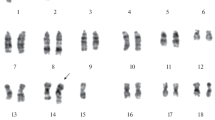Abstract
The effects of gentamicin on cellular physiology were studied in a total of 9 mammalian cell lines, using the following parameters: cell morphology and viability (cytotoxicity), proliferation, culture medium acidification, lactic acid production, lactate dehydrogenase release, virus susceptibility, and effects on karyotype. With regard to cytotoxicity no gross differences could be found in the sensitivity of the diploid and aneuploid cells investigated, as judged by morphological criteria. However, cells exposed to the antibiotic in the lag-log phase of growth showed damage at lower concentrations (1000 μg/ml) than cells treated in the stationary phase (2000 μg/ml). As regards the influence of gentamicin on cell growth and metabolism, dose-response relationship were found proving that the antibiotic causes a depression of proliferation, a striking increase in lactate production, an elevated LDH release, and changes in pH behaviour. All these parameters were unaffected by concentrations up to 125 μg/ml. No gross changes in chromosome morphology and number could be detected in human lymphocytes cultivated with up to 1000 μg/ml gentamiein. The virus sensitivity towards 4 DNA- and 7 RNA-virus strains was unaffected in one diploid and one aneuploid cell line after 10 passages with 50 μg/ml gentamicin in lieu of the usual penicillin+streptomycin combination.
The minimal bactericidal concentrations (MBC) were determined in cell-free media and in tissue cultures against 4 species of bacteria. The MBC of gentamicin was generally lower as compared with the penicillin+streptomycin combination. In some instances MBC was higher in the presence than in the absence of tissue culture cells. Comparison of the bactericidal efficiency against 31 strains of 7 species of bacteria of gentamicin (50 μg/ml) and penicillin+streptomycin (100 units+100 μg/ml) in cell cultures proved that gentamicin is superior for control of bacterial growth in tissue culture.
Zusammenfassung
Der Einfluß von Gentamycin auf die Zellphysiologie wurde an insgesamt 9 Säugetierzellinien untersucht, wobei die folgenden Parameter geprüft wurden: Zellmorphologie und Vitalität (Cytotoxicität), Vermehrung, Ansäuerung des Kulturmediums, Milchsäureproduktion, Freisetzung von Lactatdehydrogenase, Virusempfindlichkeit und Wirkung auf den Karyotyp. In bezug auf die Cytotoxicität konnten mit Hilfe morphologischer Kriterien keine groben Unterschiede in der Empfindlichkeit der untersuchten diploiden und aneuploiden Zellen gefunden werden. Es wurden jedoch bei niedrigeren Konzentrationen (1000 μg/ml) Schädigungen an Zellen beobachtet, die sich in der exponentiellen Wachstumsphase befanden als an solchen in der stationären Wachstumsphase (2000 μg/ml). Bezüglich des Einflusses von Gentamycin auf Zellwachstum und -metabolismus wurden Dosis-Wirkungsbeziehungen ermittelt, die eine Wirkung des Antibioticums im Sinne einer Vermehrungshemmung, einer auffälligen Zunahme der Lactatproduktion, einer erhöhten LDH-Freisetzung und Veränderungen im Verhalten des pH aufzeigten. Diese Parameter waren sämtlich von Konzentrationen bis zu 125 μg/ml unbeeinflußt. An menschlichen Lymphocyten, die mit bis zu 1000 μg/ml Gentamycin kultiviert waren, konnten keine groben Veränderungen der Chromosomenzahl und -morphologie entdeckt werden. Die Virusempfindlichkeit je einer diploiden und aneuploiden Zellinie, die über 10 Passagen mit 50 μg/ml Gentamycin anstelle der üblichen Penicillin-Streptomycin-Kombination gezüchtet worden waren, war gegenüber 4 DNS- und 7 RNS-Virusstämmen unverändert.
Bactericidieprüfungen an 4 Keimarten ergaben eine i. allg. geringere minimale bactericide Konzentration (MBK) von Gentamycin als von der Kombination Penicillin-Streptomycin. Die MBK lag in Gewebskulturen in einigen Fällen höher als in Medien ohne Zellen. Beim Vergleich der bactericiden Wirksamkeit von Gentamycin (50 μg/ml) und der Penicillin-Streptomycin-Kombination (100 I.E=100 μg/ml) gegenüber 31 Bakterienstämmen von 7 Arten erwies sich das Gentamycin den „klassischen“ Antibiotica überlegen.
Similar content being viewed by others
References
Casemore, D. P.: Gentamicin as a bactericidal agent in virological tissue cultures. J. clin. Path.20, 298–299 (1967)
Fischer, A. B., Manojlovic, N., Kuwert, E., Beck, E.-G.: Cytogenetische Charakterisierung der Zellinien BHK-21 C13 und BHK-21 C13S. Arch. ges. Virusforsch.33, 375–384 (1971)
Fogh, J., Lund, R. O.: Continuous cultivation of epithelial cell strain (FL) from human amniotic membrane. Proc. Soc. exp. Biol. (N.Y.)94, 532–537 (1957)
Kärber, G.: Beitrag zur kollektiven Behandlung pharmakologischer Reihenversuche. Naunyn-Schmiedebergs Arch. exp. Path. Pharmak.162, 480–483 (1931)
Kuwert, E., Scvorc, R., Hienz, H. A., Manojlovic, N.: Cytologische und cytogenetische Untersuchungen an den Essener Zellinien HeLa, KB, Fl und MS sowie an Rhesusaffennierenzellen. Z. med. Mikrobiol. u. Immunol.154, 97–116 (1968)
Litwin, J.: The effect of commercial and pure gentamicin on the growth of human diploid lung fibroblasts. Acta path. microbiol. scand., Sect. B78, 273–276 (1970)
Metzger, J. P., Fusillo, M. D., Cornman, I., Kuhns, M. D.: Antibiotics in tissue culture. Exp. Cell. Res.6, 337–344 (1954)
Milanesi, G., Ciferri, O.: Studies on the mechanism of action of gentamicin. Effect on protein synthesis in cell-free extracts ofEscherichia coli. Biochemistry5, 3926–3935 (1966)
Münch, R., Beck, E. G., Manojlovic, N.: Untersuchungen über die Reaktion in vitro gezüchteter Zellen nach kurzzeitiger Inkubation mit SiO2-Staub. Beitr. Silikoseforsch. (Pneumokon.)23, 175–205 (1971)
Munyon, W. H., Merchant, D. J.: The relation between glucose utilization, lactic acid production and utilization and the growth cycle of L strain fibroblasts. Exp. Cell Res.17, 490–498 (1959)
Rudin, A., Healy, A., Phillips, C. A., Gump, D. W., Forsyth, B. R.: Antibacterial activity of gentamicin sulphate in tissue culture. Appl. Microbiol.20, 989–990 (1970)
Sarre, S. G., Hahn, F. E.: Mode of action of gentamicin. Trans. N.Y. Acad. Sci.29, 575–578 (1967)
Schafer, T. W., Pascale, A., Shimonaski, G., Came, P. E.: Evaluation of gentamicin for use in virology and tissue culture. Appl. Microbiol.23, 565–570 (1972)
Shaffer, J. M., Kucera, C. J., Spink, W. W.: The protection of intracellular brucella against therapeutic agents and the bactericidal action of serum. J. exp. Med.97, 77–89 (1953)
Shepard, C. C.: The use of HeLa cells infected with tubercle bacilli for the study of antituberculous drugs. J. Bact.73, 494–498 (1957)
Shipman, C.: Evaluation of 4-(2-hydroxyethyl)-1-piperazineëthanesulfonic acid (HEPES) as a tissue culture buffer. Proc. Soc. exp. Biol. (N.Y.)130, 305–310 (1969)
Author information
Authors and Affiliations
Rights and permissions
About this article
Cite this article
Fischer, A.B. Gentamicin as a bactericidal antibiotic in tissue culture. Med Microbiol Immunol 161, 23–39 (1975). https://doi.org/10.1007/BF02120767
Received:
Issue Date:
DOI: https://doi.org/10.1007/BF02120767



